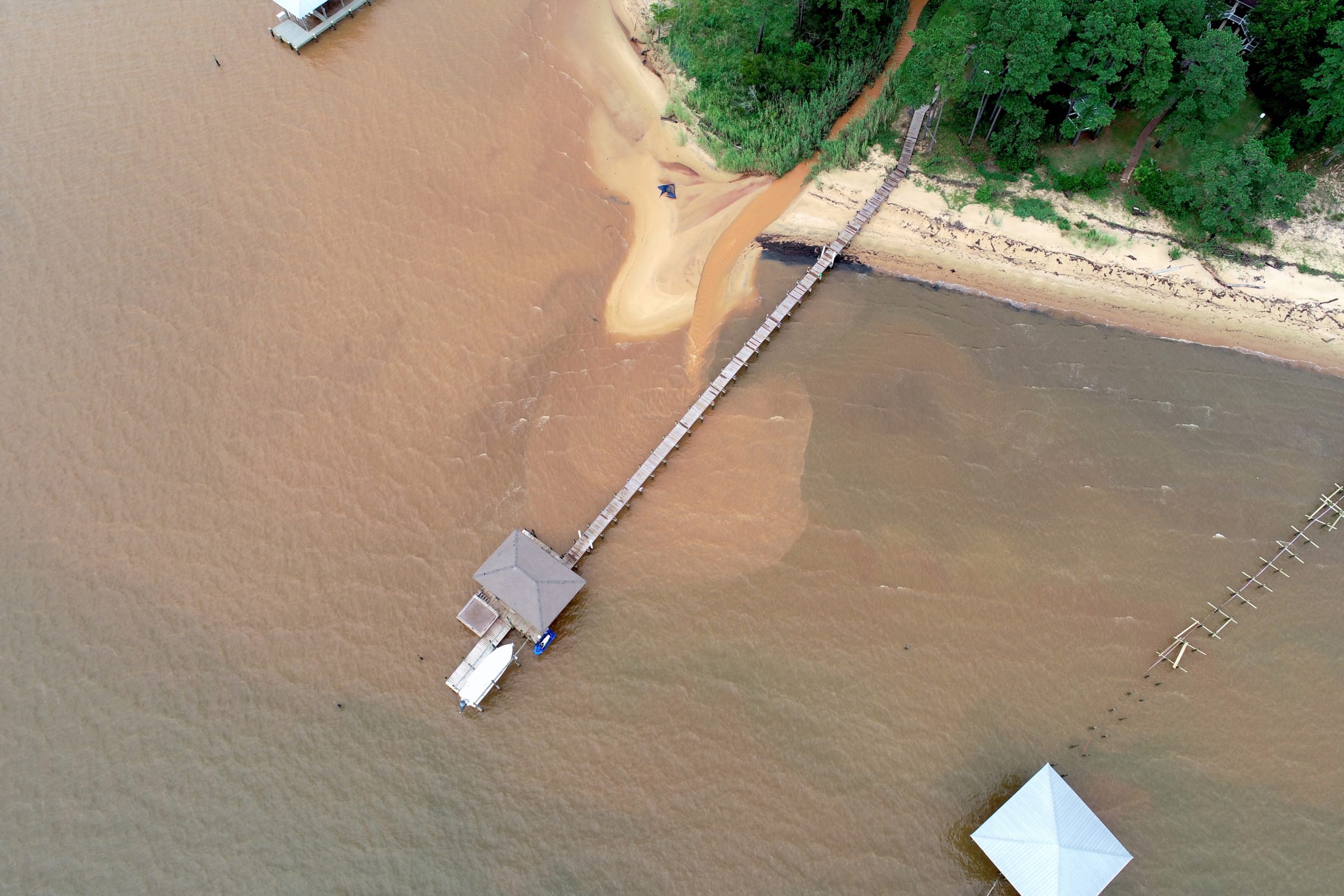
This article is from the forthcoming Fall edition of Mobile Baykeeper’s print quarterly, CURRENTS. The magazine is mailed to active members who have given more than $50 in 2023. To get on the magazine’s mailing list, donate here.
By Cade Kistler
Our community’s heart beats in rhythm with the gentle lap of Mobile Bay’s waters. Fish fries, lazy days on the shore, traditions handed down through generations — the vibrance of our Bay is deeply woven into the fabric of our lives. But this tapestry is unraveling, strand by strand, as uncontrolled stormwater pollution from construction smothers our cherished waters.
Where past generations gazed at crystal-clear streams and seagrass dancing in the tide, now rivers of silt run through our fingers. This muddiness has profoundly impacted Mobile Bay’s ecology as sunlight essential for aquatic plants is blocked. A 2002 analysis by the Mobile Bay National Estuary Program revealed staggering losses — 70 percent of mid-20th century submerged aquatic vegetation (SAV) coverage had vanished, plummeting from 1,924 acres in 1940 to just more than 855 acres in 2002. A 2009 study showed this decline continuing. These underwater grasses once spanned the Bay, filtering sediment and nourishing wildlife. Now massive swaths of barren bottoms lie where green meadows once swayed.
The statistics paint a sobering portrait, one that naturalist and eco-tour guide Jimbo Meador has seen play out first-hand. “The Bay is always muddy now. We’ve lost all our seagrasses. Without sunlight, seagrass can’t photosynthesize. Muddy water is like putting a tarp over your lawn — no grass will grow.”
Sediment also suffocates oysters, mussels, and fish populations. Once diverse stream beds have become silted wastelands, inhospitable to bugs, shrimp, crabs, and oysters.
The human toll is no less severe. Waterfront home-values can plunge more than 20 percent as dredging becomes a prerequisite for usable docks and boathouses. Fly Creek tells this story vividly. Before construction of the shopping center, the creek was navigable by small boats well upstream of Scenic Highway 98. Today, just a few hundred yards above the bridge at Scenic 98, the creek has shoaled into an impassable trickle, even for kayaks.
While stormwater pollution has many sources, uncontrolled runoff from construction sites represents a significant contributor, especially when it comes to land-disturbing projects like new subdivisions. Poor compliance and oversight allow uncontrolled sediment to wash from these sites into nearby streams during rain events. Weak enforcement enables short-sighted developers to shirk preventative measures.
Despite more than 260 warning letters in 2022, ADEM issued just 17 consent orders with penalties. The rare penalties that are imposed often pack all the punch of a pillow fight.
For example, DR Horton, a national residential-developer, has received 12 warning letters and four notices of violation in 2022. For that, they received one fine; their development at Stonebridge construction was repeatedly found by ADEM to be allowing mud to run into and pollute the Fish River, yet they were fined only $22,750. For a company with $33.48 billion in revenue for that year, this represented just 0.00007 percent of earnings.
With such muted enforcement, ADEM has inadvertently created an economic incentive for developers to ignore protections for waterways. Of course, ADEM faces real constraints — limited staffing, funding, and outdated regulations — in trying to address today’s complex stormwater issues.
But the core problem is ADEM’s collaboration with developers, largely in place of real enforcement needed to improve compliance. If violating regulations remains cheaper than compliance, many will continue taking that route rather than invest in preventative measures. This is especially true when consequences for violations are rare and weak. The reality is that unless non-compliance has tangible financial repercussions, some businesses will cut corners to save money at the expense of our waters and those downstream.
But our waters don’t belong to developers; they are the beating heart of countless livelihoods and our shared cultural heritage. ADEM must impose substantive stop-work orders and fines that outweigh potential costs saved by non-compliance.
Warnings and collaboration alone cannot overcome this economic reality. Strong enforcement makes doing right more profitable than doing wrong — and evens the playing field for those developers who have committed to doing the right thing. For the sake of our waters, our wildlife, and our coastal heritage, the time has come to make this so.
That is why we are calling for accountability and action. Baykeeper is committed to:
We must write a new story for Mobile Bay, one where we protect what is ours, where we honor the legacy inherited from past generations and work to leave an untarnished one of our own.
In the coming year, we’ll be calling on you for help in changing these policies and improving construction stormwater. If you want to be a part of that campaign, text ‘stop mud’ to (251) 220-7685, or visit MobileBaykeeper.org/stop-mud as we stand up for clear waters, seagrass restoration, and for a vibrant, living Bay. The time to act is now. Our waters and heritage demand nothing less.
Photo: Aerial image of Red Gully emptying into Mobile Bay. Mud from construction occurring upstream of where this photo was captured, on and near U.S. 98 in Daphne, flows downstream through Red Gully negatively impacting nearby property owners and polluting Mobile Bay.
